戴安公司AS11-HC阴离子交换分离柱
离子交换层析柱子的选择
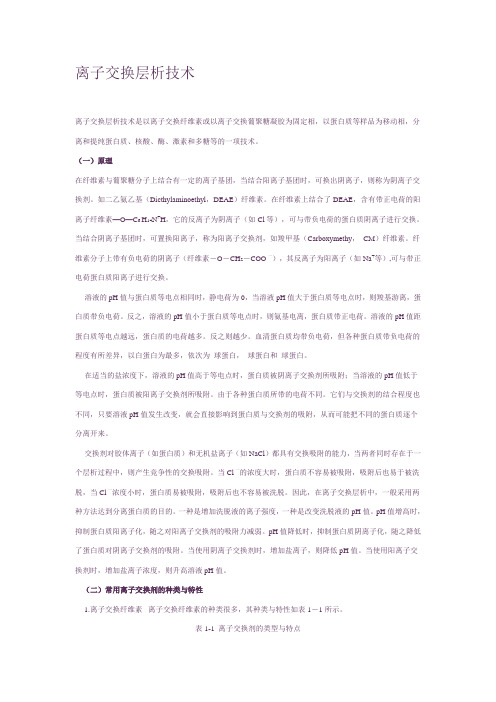
离子交换层析技术离子交换层析技术是以离子交换纤维素或以离子交换葡聚糖凝胶为固定相,以蛋白质等样品为移动相,分离和提纯蛋白质、核酸、酶、激素和多糖等的一项技术。
(一)原理在纤维素与葡聚糖分子上结合有一定的离子基团,当结合阳离子基团时,可换出阴离子,则称为阴离子交换剂。
如二乙氨乙基(Dicthylaminoethyl,DEAE)纤维素。
在纤维素上结合了DEAE,含有带正电荷的阳离子纤维素—O—C6 H14N+H,它的反离子为阴离子(如Cl-等),可与带负电荷的蛋白质阴离子进行交换。
当结合阴离子基团时,可置换阳离子,称为阳离子交换剂,如羧甲基(Carboxymethy,CM)纤维素。
纤维素分子上带有负电荷的阴离子(纤维素-O-CH2-COO一),其反离子为阳离子(如Na+等),可与带正电荷蛋白质阳离子进行交换。
溶液的pH值与蛋白质等电点相同时,静电荷为0,当溶液pH值大于蛋白质等电点时,则羧基游离,蛋白质带负电荷。
反之,溶液的pH值小于蛋白质等电点时,则氨基电离,蛋白质带正电荷。
溶液的pH值距蛋白质等电点越远,蛋白质的电荷越多。
反之则越少。
血清蛋白质均带负电荷,但各种蛋白质带负电荷的程度有所差异,以白蛋白为最多,依次为球蛋白,球蛋白和球蛋白。
在适当的盐浓度下,溶液的pH值高于等电点时,蛋白质被阴离子交换剂所吸附;当溶液的pH值低于等电点时,蛋白质被阳离子交换剂所吸附。
由于各种蛋白质所带的电荷不同。
它们与交换剂的结合程度也不同,只要溶液pH值发生改变,就会直接影响到蛋白质与交换剂的吸附,从而可能把不同的蛋白质逐个分离开来。
交换剂对胶体离子(如蛋白质)和无机盐离子(如NaCl)都具有交换吸附的能力,当两者同时存在于一个层析过程中,则产生竞争性的交换吸附。
当Cl一的浓度大时,蛋白质不容易被吸附,吸附后也易于被洗脱,当Cl一浓度小时,蛋白质易被吸附,吸附后也不容易被洗脱。
因此,在离子交换层析中,一般采用两种方法达到分离蛋白质的目的。
离子色谱

离子交换色谱摘要:离子交换色谱主要包括阴离子交换色谱和阳离子交换色谱。
本文介绍了,离子交换色谱的分离原理,检测方法,淋洗液、色谱柱类型和特点,以及离子交换色谱的应用。
离子色谱(IC)是高效液相色谱(HPLC)的一种,是分析阴离子和阳离子的一种液相色谱方法。
离子色谱的分离机理主要是离子交换,有3种分离方式,它们是高效离子交换色谱(HPIC)、离子排斥色谱(HPIEC)和离子对色谱(MPIC)。
3种分离方式的柱填料的树脂骨架基本都是苯乙烯-二乙烯基苯的共聚物,但树脂的离子交换功能基和容量各不相同。
HPIC 用低容量的离子交换树脂,HPIEC用高容量的树脂,MPIC用不含离子交换基团的多孔树脂。
3种分离方式各基于不同分离机理:HPIC的分离机理主要是离子交换,HPIEC主要为离子排斥,而MPIC则是主要基于吸附和离子对的形成。
离子交换色谱的离子交换分离基于流动相和固定相上的离子交换基团之间发生的离子交换过程。
对高极化度和疏水性较强的离子,分离机理还包括非离子交换的吸附过程。
离子交换色谱主要是用于无机和有机阴离子和阳离子的分离。
离子交换功能基为季铵基的树脂用作为阴离子分离,为磺酸基和羧酸基的树脂作为阳离子分离。
离子交换色谱主要用于分析常见的Cl-,F-,Br-等无机阴离子,有机酸,糖和氨基酸等有机阴离子,分析的阳离子主要是同一元素的多种价态金属阳离子的分离与分析;离子排斥色谱主要用于分离和分析有机酸和无机酸;离子对色谱主要是用于对表面活性剂的分离和分析。
1分离原理离子交换色谱的色谱柱的填料主要由基质(substrate material)和功能基(functional)两部分组成。
功能基是可解离的无机基团,与流动相接触,在固定相表面形成带电荷的离子交换位置,与流动相中的离子发生离子交换,在离子交换反应中,功能基的本体结构不发生明显变化,仅由其离子交换功能基的离子与外界同性电荷的离子发生等量离子交换。
色谱柱填料又被称为“离子交换剂”[1]。
戴安-hilic柱说明书
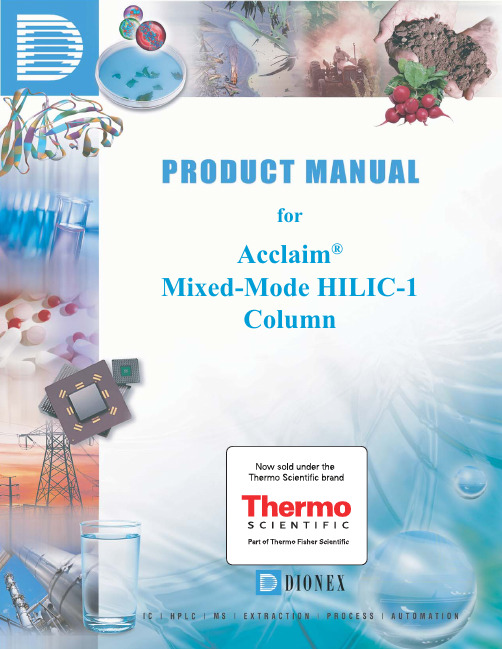
forAcclaim®Mixed-Mode HILIC-1ColumnProduct ManualforACCLAIM® Mixed-Mode HILIC-1 Column5µm, 4.6 x 250mm, P/N 0668445µm, 4.6 x 150mm, P/N 0668435µm, 2.1 x 150mm, P/N 0668473µm, 3.0 x 150mm, P/N 0700903µm, 3.0 x 50mm, P/N 0719123µm, 2.1 x 150mm, P/N 070091 ACCLAIM® Mixed-Mode HILIC-1 Guard4.3 x 10mm (set of 2), P/N 0668452.1 x 10mm (set of 2), P/N 0668463.0 x 10mm (set of 2), P/N 0719134.6 x 10mm (set of 2), P/N 069706© 2009 Dionex CorporationDocument No. 065198Revision 02July 2009TABLE OF CONTENTSSECTION 1 – Introduction (3)1.1. Specifications and Recommended Operating Conditions (3)1.2. Physical (4)1.3. Acclaim Mixed-Mode HILIC-1 Products (4)SECTION 2 – INSTALLATION: Step-by-Step User Guide (5)SECTION 3 – Considerations in Method Development (7)3.1. HILIC Mode vs. Reversed-Phase Mode (7)3.2. Selection of Organic Solvents (7)3.3. Buffer Types (7)3.4. Mobile Phase pH (7)3.5. Isocratic or Gradient Method (7)SECTION 4 – Column Care (8)4.1. Column storage (8)4.2. Operating pH range: pH 2.5 to 7.5 (8)4.3. Operating temperature limit: 50 ºC (8)4.4. Pressure limit < 4000 psi (8)4.5. Flow rate (8)4.6. Column washing procedure (8)SECTION 5 – Frequent Asked Questions (9)SECTION 6 – Applications (10)6.1. Dual Operation Modes: Reversed-phase and HILIC (10)6.2. Analysis of Urea (11)6.3. Complementary Selectivity: Reversed-phase and HILIC (12)6.4. Dependency of Retention on Mobile Phase Organic Content:Comparison between the Acclaim HILIC and LiChrosorb Diol (13)6.5. Analysis of NEODOL 25-12 (14)6.6. Analysis of Alkylphenol Ethoxylate (15)6.7. Separation of Polyethylene Glycols (16)SECTION 7 – Troubleshooting Guide (17)7.1. High Backpressure (17)7.1.1. Finding the Source of High System Pressure (17)7.1.2. Contaminated guard or analytical column (17)7.2. High Background or noise (17)7.2.1. Preparation of Mobile Phases (17)7.3. Poor Peak Resolution (17)7.3.1. Loss of column Efficiency (17)SECTION 1 – INTRODUCTIONThe Acclaim Mixed-Mode HILIC-1 column is a silica-based packing material that incorporates both Reversed-Phase (RP) and Hydrophilic Interaction Liquid Chromatography (HILIC) properties. Unlike either traditional RP or HILIC stationary phases, the packing features an alkyl long chain with a hydrophilic polar terminus, and demonstrates great potentials for separating a wide range of both highly polar and non-polar molecules, in either RP mode or HILIC mode.The Acclaim Mixed-Mode HILIC-1 columns consist of 5-µm or 3-µm high-purity, porous, spherical silica particles with 120Å diameter pores bonded with proprietary functional groups, which provide unsurpassed resolution and peak symmetry for a variety of polar and non-polar molecules.The main features of the Acclaim HILIC-1 column include1. Operates in both reversed-phase and normal phase modes.2. Retains highly polar molecules that would be un-retained by reversed-phase chromatography.3. Unique selectivity, complementary to reversed-phase columns.4. Higher hydrophobic retention compared to the conventional Diol columns.5. Broader application range than conventional Diol columns.1.1.Specifications and Recommended Operating ConditionsShipping Solution 60 / 40 Acetonitrile / 100mM Ammonium AcetateStorage Solution: 60 / 40 Acetonitrile / 100mM Ammonium Acetateor HILIC mobile phaseBuffer pH Range: pH 2.5 - 7.5Temperature Range < 50°CStationary Phase ParticlesizeColumnDimensionsP/NMax RecommendedPressureTypical Flow Rate2.1x150 mm0700915800 psi0.2 - 0.5 mL/min3.0x50 mm0719124500 psi0.4 - 1.0 mL/min 3 µm3.0x150 mm0700905800 psi0.4 - 1.0 mL/min2.1x150 mm0668475800 psi0.2 - 0.5 mL/min4.6x150 mm0668435800 psi0.8- 2.0 mL/minMixed-Mode HILIC-15 µm4.6x250 mm0668445800 psi0.8 - 2.0 mL/min1.2.PhysicalBonding Chemistry: Proprietary alkyl diol Silica Substrate: Spherical, high-purity Particle size 5 µm and 3µmSurface area 300 m2/gPore size 120 Å1.3.Acclaim Mixed-Mode HILIC-1 ProductsAcclaim Mixed-Mode HILIC-1 ParticlesizeColumnDimensionsP/N2.1x150 mm 0700913.0x50 mm 0719123 µm3.0x150 mm 0700902.1x150 mm 0668474.6x150 mm 066843Analytical5 µm4.6x250 mm 0668444.3 x 10mm 066845 Requires Holder p/n 0594562.1 x 10mm 066846 Requires Holder V-2 p/n 0695803.0 x 10mm 071913 Requires Holder V-2 p/n 069580 Guard 5µm4.6 x 10mm 069706 Requires Holder V-2 p/n 069580SECTION 2 – INSTALLATION: STEP-BY-STEP USER GUIDEStep 1 - Validating column performanceDionex recommends that you perform an efficiency test on your Acclaim Mixed-Mode HILIC column before use. The purpose of column performance validation is to ensure no damage has occurred during shipping. Test the column using the conditions described on the Quality Assurance (QA) Report enclosed in the column box. Repeat the test periodically to track the column performance over time. Note that slight variations may be obtained on tow different HPLC systems due to system electronic, plumbing, operating environment, reagent quality, column conditioning, and operator technique.Step 2 - Mobile phase preparationObtaining reliable, consistent and accurate results require mobile phases that are free of ionic and spectrophotometric impurities. Chemicals, solvents and de-ionized water used to prepare mobile phase should be of the highest purity available. Maintaining low trace impurities and low particle levels in mobile phases helps to protect your columns and system components. DIONEX cannot guarantee proper column performance when the quality of the chemicals, solvents and water used to prepare the mobile phase has been compromised.De-ionized WaterThe de-ionized water used to prepare the mobile phase should be Type 1 Reagent Grade Water, or HPLC Grade Water. The de-ionized water should be free of ionized impurities, organics, microorganisms and particulate matter larger than 0.2 µm. Many commercial water purifiers are designed for HPLC applications and are suitable for these applications.NOTE Degas the aqueous component of the mobile phase and then add the solvent component. Avoid excessive purging or degassing of mobile phases containing solvents, if possible, since the volatile solvent can be 'boiled' off from the solution.SolventsThe solvents used must be free from ionic and UV-absorbing impurities. Use of ultrahigh purity solvents, HPLC grade, will usually ensure that your chromatography is not affected by impurities in the solvent.Depending on specific application, the mobile phase system consists of an organic modifier (e.g. acetonitrile or methanol) and an aqueous portion (e.g. D.I. water, or ammonium acetate or phosphate buffer). Both pre-mixed and proportioning valve generated mobile phases give satisfactory results. The use of proportioning valve provides better flexibility in method optimization, while the pre-mixed mobile phase provides more reproducible results.Mobile Phase for Column Performance Test:Pre-mixed mobile phase: mix 400 g of D.I. water and 468 g of acetonitrile.Proportioning valve generated: set up the gradient pump as 40/60 v/v D.I. water/ acetonitrile.NOTEThese two mobile phases could give slightly different results due to the ways they are prepared.Step 3 - Set up the LC systemUse a standard LC system equipped with a LC pump, a column oven, a UV detector, and an injector (or an autosampler). The system should be thoroughly primed before use.Step 4 - Condition the columnEach new column is shipped in the mobile phase used for the column performance test. Depending on different separation modes, the column should be conditioned differently.For HILIC mode (>70% acetonitrile in the mobile phase) applications, the column should be purged with 50% acetonitrile in D.I. water (v/v) for approximately 10 column volumes, followed by equilibration with the desirable mobile phase thoroughly (~20 to 50 column volumes depending on the aqueous content in the mobile phase) before any injection is made.For RP mode (<70% acetonitrile in the mobile phase) applications, the column should be purged with 50% acetonitrile in D.I. water (v/v) for approximately 10 column volumes, followed by equilibration with the desirable mobile phase thoroughly (~20 column volumes) before any injection is made.When switching to a different mobile phase, make sure that the new mobile phase is compatible with the existing mobile phase in the column to avoid column clogging due to precipitation. A good practice is to purge the column with 50% acetonitrile in D.I. water (v/v) for approximately 10 column volumes before switching to the new mobile phase.Step 5 - Reproduce the chromatogram in the Lot Validation ReportPerform the column QA test using the conditions described in the QAR (Appendix), and compare the result with the reported values. The column should be fully equilibrated before any injection. At least three injections should be made until reproducible result is obtained.NOTE Due to various reasons, such as difference of LC systems, mobile phases, oven temperature control, etc, you may observe somewhat different separation from that in the report.Once you are satisfied with the column performance report result, the column is ready for real applications.SECTION 3 – CONSIDERATIONS IN METHOD DEVELOPMENT3.1.HILIC Mode vs. Reversed-Phase ModeThe selection of separation mode depends on the type of the analyte molecules and requirement of the specific application. In general, if a highly polar molecule is the analyte of interest, HILIC mode (high organic in the mobile phase) should be considered. In addition, HILIC mode can be used to determine the degree of ethoxylation (EO) of a nonionic surfactant. For other applications, RP separation may be considered. However, it is recommended that a conventional RP column (C18, C8, or polar-embedded phase) be tried first for regular RP applications. The Acclaim HILIC column has lower hydrophobicity than C8 columns but much higher hydrophobic retention than conventional Diol columns because of its unique surface chemistry, so that selectivity different from RP columns is possible.3.2.Selection of Organic SolventsFor HILIC applications, acetonitrile is preferred as the organic modifier.For RP applications, both acetonitrile and methanol can be used depending on the application.In addition, this column is compatible with traditional normal-phase solvent, such as ethanol, iso-propanol, ethyl acetate, hexane, heptane, etc.3.3.Buffer TypesThe selection of buffer depends on the detection method and pH requirement.Ammonium acetate (or formate) buffer is the preferred buffer system because of its applicability to both RP and HILIC separation modes, compatibility with UV (> 230 nm), ELS detector and MS, high solubility in organic solvent, familiarity to most chromatographers.Volatile organic acids, such as acetic acid, formic acid, and TFA, can also be used to control the mobile phase pH, and share the similar benefits of ammonium acetate (formate) buffer.Phosphate buffers are ideal for applications that require low UV background, and it usually provides somewhat better peak shapes for charged molecules, compared to acetate buffer. Although there is no problem in RP application(organic content < 70%), phosphate buffers tend to precipitate in high organic condition.3.4.Mobile Phase pHMobile phase pH needs to be controlled to adjust selectivity and obtain reproducible results of charged molecules.3.5.Isocratic or Gradient MethodIsocratic methods are suitable for simple and/or well-defined application. When dealing with unknown samples, or a sample consisting of molecules with dramatically different hydrophilicity or hydrophobicity, a gradient method is often advantageous.SECTION 4 – COLUMN CARE4.1. Column storageThe column can be stored in the mobile phase for short period of time (e.g. overnight). If not in use for longer than one week, it is recommended to store the column in a solution with higher organic content, such as 70/30 v/v acetonitrile (or methanol)/20-100 mM ammonium acetate or D.I. water at a pH between 3.5 and 5.5.4.2. Operating pH range: pH 2.5 to 7.5The column lifetime depends heavily on the chromatographic condition. To obtain better column lifetime, it is highlyrecommended to use "silica friendlily" mobile phases, such as a buffer at a pH between pH 3 to 7. Although compatible with 100% aqueous mobile phase, it is not recommended to use this column extensively in such condition. The mobile phase pH should be controlled between 3.5 and 6 if more than 80% buffer is present in the mobile phase. If used in HILIC conditions, the column can be used in pH 2 to 8 range.4.3. Operating temperature limit: 50 ºCAlthough our experimental results indicate that the column can be used at 50 °C, a lower operating temperature (20 - 40 °C) is recommended for routine separations.4.4. Pressure limitIt is extremely important not to impose sudden column pressure surge. The maximum recommended pressures are listed in section 1.1, the use of lower operating pressures will extend column lifetime.4.5. Flow rateThe typical operating flow rates are listed in section 1.1, higher flow rate can be used for faster analysis as long as the pressure limit is not exceeded.4.6. Column washing procedureAll samples should be pre-treated and filtered before being injected on the column. In the event of column washing practice is needed, the following procedure can be used as a guideline: For a 4.6 mm i.d. column:1. Wash the column with D.I water /acetonitrile v/v 50/50 for 10 column volumes at a flow rate between 0.5 to 1mL/min.2. Wash the column with 0.1 M ammonium acetate pH 4 to 5 /acetonitrile v/v 50/50 for 20 column volumes at a flowrate between 0.5 to 1 mL/min.3. Wash the column with 0.1 M ammonium acetate pH 4 to 5 /acetonitrile v/v 10/90 for 20 column volumes at a flowrate between 0.5 to 1 mL/min.4. Wash the column with 0.1 M ammonium acetate pH 4 to 5 /acetonitrile v/v 50/50 for 20 column volumes at a flowrate between 0.5 to 1 mL/min.5. Before any injection is made, the column should be equilibrated with the mobile phase thoroughly.NOTEFor a 2.1 mm i.d. column, the flow rate should be reduced to 20% of that for 4.6 mm i.d column.NOTEIf above treatment fails to revive the column, the column should be replaced.SECTION 5 – FREQUENT ASKED QUESTIONS1. What is the difference between the Acclaim Mixed-Mode HILIC-1 column and conventional HILIC (Diol) column? The Acclaim HILIC-1 column is based on a new silica-based mixed-mode stationary phase that incorporates both RP and HILIC properties. Unlike either traditional RP or HILIC stationary phases, the new packing features an alkyl long chain with a hydrophilic polar terminus, and demonstrates broader applications for separating a wide range of both highly polar and non-polar molecules, in either RP mode or HILIC mode (Figure 1). By comparison, conventional Diol columns have significantly decreased hydrophobicity (Figure 2), and have much narrower application range.2. Why do I need an Acclaim Mixed-Mode HILIC-1 column?The Acclaim HILIC-1 column combines both RP and HILIC characteristics. It can be used in either HILIC conditions or RP conditions the same way as conventional Diol columns or RP columns, without special requirements. More importantly, the optimal balance between the hydrophilic and hydrophobic portions on the column surface leads to unique selectivity that neither conventional Diol columns nor RP columns can provide.3. When do I need an Acclaim Mixed-Mode HILIC-1 column?You should consider using an Acclaim HILIC-1 column when1) Regular RP (e.g. C18, C8, polar-embedded phase, etc) and HILIC (e.g. Diol, CN, amino, silica) columns fail toprovideresults;satisfactory2) You are dealing with highly polar molecules, or very hydrophobic molecules;3) You need orthogonal selectivity to complement the primary method;4) You are analyzing ethoxylated surfactants (Figures 6 - 8).4. What factors should I consider for method development using this column?During method development, the following factors should be considered:1) Separation mode2) Type of organic modifier3) Aqueous content in the mobile phase4) Mobile phase pH control5) Temperature5. What mobile phases should I use with this column?The new column is compatible with any mobile phases for HILIC or Normal-Phase separations provided that the pH requirement is met.The new column is compatible with any mobile phases for Revered-Phase separations provided that the pH requirement is met. However, for typical RP applications, a RP column (C18 or C8) should be tried first.Please refer to "Section 3 Considerations in Method Development" for more details.6. What should I do before starting using Acclaim Mixed-Mode HILIC-1 column?Read this User Guide carefully, and contact Dionex Technical Support if you have any questions regarding using this column.7. Can I use this column in normal-phase mode?Yes. The column is compatible with traditional normal-phase solvent, such as ethanol, iso-propanol, ethyl acetate, hexane, heptane, etc.8. How to store the column?The column can be stored in the mobile phase for short period of time (e.g. overnight). If not in use for longer than one week, it is recommended to store the column in a solution with higher organic content, such as 70/30 v/v acetonitrile (or methanol)/20-100 mM ammonium acetate or D.I. water at a pH between 3.5 and 5.5.SECTION 6 – APPLICATIONS6.1.Dual Operation Modes: Reversed-phase and HILICAUMinutesColumn: Acclaim Mixed-Mode HILIC-1, 5 µmDimensions: 4.6 x 150 mmMobile Phase: CH3CN/0.1 NH4OAc, pH5.2v/v 52/48 for RP mode;v/v 92/8 for HILIC mode°CTemperature: 30Flow Rate: 1 mL/minInj. Volume: 10 µLDetection: UV @ 254 nmeach)ppmPeaks: (100Cytosine1.Naphthalene2.6.2.Analysis of Urea486210MinutesmV95/5 v/v CH 3CN/0.1 M NH 4OAc, pH4.597/3 v/v CH 3CN/0.1 M NH 4OAc, pH4.597.5/2.5 v/v CH 3CN/0.1 M NH 4OAc, pH4.5Column: Acclaim Mixed-Mode HILIC-1, 5 µm Dimensions: 4.6 x 150 mm Mobile Phase: See chromatograms for details Temperature: 30°C Flow Rate: 1 mL/min Inj. Volume: 10 µL Detection: Sedex 85 ELS detector (gain - 9, 50ºC) Sample: Urea (0.1% in 90% CH 3CN)6.3.Complementary Selectivity: Reversed-phase and HILIC81612420MinutesAUCH 3CN/0.1NH 4OAc,pH5.2 v/v 97.5/2.5CH 3CN/0.1NH 4OAc,pH5.2 v/v 60/40123213Acclaim 120C8Acclaim Mixed-Mode HILIC-1Column: 5 µm Dimensions: 4.6 x 150 mm Mobile Phase: CH 3CN/0.1 NH 4OAc, pH5.2 Temperature: 30 °C Flow Rate: 1 mL/min Inj. Volume: 5 µL Detection: UV @ 254 nm Peaks:1. Toluene2. Caffeine3. Benzoic acid6.4.Dependency of Retention on Mobile Phase Organic Content:Comparison between the Acclaim HILIC and LiChrosorb DiolColumn: Acclaim Mixed-Mode HILIC-1, LiChrosorb Diol, 5 μmMobile Phase: CH3CN/0.1 NH4OAc, pH5.2Flow Rate: 1 mL/minDetection: UV @ 254 nmDimensions: 4.6 x 150 mmTemperature: 30°CInj. Volume: 5 µL6.5.Analysis of NEODOL 25-1281612420MinutesC12C13C14C15C12C13C14C15Acclaim HILICAcclaim 120C8NEODOL 25–12R (OCH 2CH 2)n OH R = C 12 to C 15n ~Column: 5 µm Dimensions: 4.6 x 150 mm Mobile Phase: A - CH 3CN, B - D.I. H 2O Gradient: 30% to 80% A in 15 min,then hold for 5 min Temperature: 30 °C Flow Rate: 1.5 mL/min Inj. Volume: 10 µLDetection: ELS Detector Sample: NEODOL 25-12 (0.2%)6.6.Analysis of Alkylphenol Ethoxylate122418630MinutesAUIGEPAL CA-630n ~9C 8H 17(OCH 2CH 2)n OHAcclaim HILICLiChro sorb DiolAcclaim 120 C8Column: See chromatograms for details, 5 µm Dimensions: 4.6 x 150 mm Mobile Phase: 99/1 v/v CH 3CN/0.1 M NH 4OAc, pH5.2 Temperature: 30 °C Flow Rate: 1.0 mL/min Inj. Volume: 10 µL Detection: UV @ 225 nm Sample: IGEPAL CA-630 (0.1%)6.7.Separation of Polyethylene Glycols81612420MinutesmVPEG-400PEG-1000PEG-2000PEG-3400PEG-6000Column: Acclaim HILIC, 5 µm Dimensions: 4.6 x 150 mm Mobile Phase: A - MeOH, B - D.I. H 2O Gradient: 20% to 95% A in 20 min Temperature: 30 °C Flow Rate: 1 mL/min Inj. Volume: 25 µLDetection: ELSD Samples: Various PEGs (0.04% each)SECTION 7 – TROUBLESHOOTING GUIDEThe following instruction should help you to locate and eliminate problems traceable to hardware and chemistry issues. Please keep in mind that some problems may be due to other reasons, such as sample contamination, poor water quality, etc. If you cannot solve your problems with the help of this manual, please contact you local Dionex customer support specialist.7.1.High Backpressure7.1.1.Finding the Source of High System PressureIf the system pressure is excessively high, determine the cause of the high pressure. The system should be used with a high-pressure in-line filter for mobile phases. The filter should be positioned between the gradient pump pressure transducer and the injection valve. Make sure you have a high-pressure in-line filter in place and that it is not contaminated.A.Make sure that the pump is set to the correct flow rate. Higher than recommended mobile phase flow rates will causehigher pressure. Measure the pump flow rate if necessary with a stop watch and graduated cylinder.B.Determine which part of the system is causing the high pressure. It could be a piece of tubing that has plugged,collapsed tubing walls from over tightening, an injection valve with a plugged port, a column with particulatesplugging the bed support, a plugged High-pressure In-line filter, or detector cell. To identify which part of thechromatographic system is causing the problem, disconnect the pump fluid line from the injection valve and turn the pump on. Watch the pressure; it should not exceed 50psi (0.34MPa). Continue adding the system components back into the fluid path, one by one, while watching the system pressure.7.1.2.Contaminated guard or analytical columnIf the column is the cause of the back pressure, replace the guard column.7.2.High Background or noise7.2.1.Preparation of Mobile PhasesA.Ensure the mobile phase is made correctly.B.Ensure the eluents are made from chemicals with the recommended purity.7.3.Poor Peak ResolutionPoor peak resolution can be due to any or all of the following factors.7.3.1.Loss of column EfficiencyA.Extra-column system effects can result in sample band dispersion, decreasing peak efficiencies. Make sure you areusing tubing with an i.d. of no greater than 0.010" (0.007" for 2.1mm) to make all liquid line connections between the injection valve and the detector cell inlet on standard bore (4-mm) systems. Check for leaks.B.Guard column / column needs to be replaced.。
湖北阴离子交换柱工作原理

湖北阴离子交换柱工作原理
湖北阴离子交换柱是一种常用的分离和纯化离子的技术工具,其工作原理如下:
1. 柱填充阴离子交换介质:柱中填充有一种阴离子交换介质,通常是一种具有大量阴离子交换基团的树脂。
这些基团具有亲和性,可以与待分离溶液中的阴离子发生离子交换。
2. 样品加载:待分离的溶液通过柱的顶部或侧面加入,样品溶液中的阴离子与阴离子交换基团发生离子交换反应。
根据样品的性质和需要,可以通过控制样品流速和溶液pH等条件来调
节样品中阴离子与阴离子交换基团的交换程度。
3. 阴离子吸附与洗脱:阴离子交换基团与样品中的阴离子进行离子交换后,被吸附在柱内,不被洗脱出来。
其他未被吸附的样品成分则通过柱底部排出。
为了完全洗脱目标物质,可以使用具有不同离子强度的洗脱缓冲液来冲洗柱子。
4. 目标物质的收集:经过多次洗脱后,目标物质会被逐步洗脱到柱的底部,可以使用收集管或分馏釜等设备来收集目标物质。
收集的目标物质可以进一步进行分析、纯化或其他处理。
总之,湖北阴离子交换柱通过阴离子交换基团与样品中的阴离子发生离子交换反应,实现了对目标物质的分离、纯化和富集。
其工作原理与样品的性质、离子交换基团的特性以及柱的设计等因素密切相关。
高分子聚合物基质阴离子交换柱

高分子聚合物基质阴离子交换柱高分子聚合物基质阴离子交换柱是一种常用的分离纯化技术,在化学、生物化学以及生物制药等领域中广泛应用。
它利用高分子聚合物基质的特殊结构和功能,实现对溶液中阴离子的选择性吸附和分离。
高分子聚合物基质阴离子交换柱的基质主要由交联的聚酸或聚酰胺构成。
这种材料具有很高的表面积和孔隙结构,能够提供丰富的吸附位点和通道,从而增加与目标溶质的相互作用机会。
此外,基质中的交联结构使得其具有良好的物理和化学稳定性,能够承受较高的流速和压力,保证分离过程的稳定性和重复性。
在高分子聚合物基质阴离子交换柱中,溶液中的阴离子会与基质上的阳离子交换,从而被固定在柱上。
这种交换作用是通过静电相互作用和化学吸附等机制实现的。
在柱中,溶液中的阴离子会与基质上的阳离子形成离子对,从而被吸附在固相基质上。
而溶液中的其他成分,如阳离子和中性物质,则可以通过柱床中的孔隙和通道流过,被洗脱出来。
为了实现对目标阴离子的选择性吸附和分离,可以通过调节溶液的pH值、离子强度和离子组成等参数来控制交换过程。
一般来说,较高的pH值和低的离子强度有利于阴离子的吸附,而较低的pH值和高的离子强度则有利于阴离子的洗脱。
此外,柱的尺寸和流速也会对分离效果产生影响,需要根据具体应用进行优化选择。
高分子聚合物基质阴离子交换柱在生物制药领域中具有重要的应用价值。
例如,在生物药物的制备过程中,常常需要对溶液中的杂质和副产物进行去除,以保证产品的纯度和质量。
阴离子交换柱可以通过选择性吸附和分离,实现对目标物质的纯化。
此外,在蛋白质和核酸的分离纯化中,也可以利用阴离子交换柱实现不同组分的分离。
除了生物制药领域,高分子聚合物基质阴离子交换柱还广泛应用于环境监测、食品安全和化学分析等领域。
例如,在环境水样的处理中,阴离子交换柱可以用于去除水中的重金属离子和有机酸,从而净化水质。
在食品安全领域,阴离子交换柱可以用于检测食品中的添加剂和污染物,保障食品的质量和安全。
阴离子交换柱的原理

阴离子交换柱的原理阴离子交换柱是一种用于离子交换和分离的实验室装置。
它的主要原理是在柱中放置了一定量的阴离子交换树脂,当样品通过这个树脂柱时,它会被分离成不同的离子并被捕获在树脂中。
在这个过程中,阴离子交换柱的化学成分起着非常重要的作用。
阴离子交换柱的树脂化学成分阴离子交换柱中的树脂通常是由含有具有阴离子交换能力的功能基团的高分子糖构成的。
这些功能基团通常是负电荷的,如四乙基铵-碘离子、季铵盐、醋酸树脂等。
这些阴离子交换树脂能够吸附和分离带正电电荷的阳离子,而不被带负电荷的阴离子所吸附。
阴离子交换柱的使用原理使用阴离子交换柱时,样品被加入到柱的顶端,逐渐渗透到树脂层。
在这个过程中,样品中的离子会与树脂中的阴离子交换基团发生化学反应,导致不同离子的分离。
离子和基团之间的反应通常是通过离子扩散的方式完成的,离子通过扩散到基团的表面,与基团发生反应并被捕获。
例如,在分离硫酸根离子和氯离子时,硫酸根会通过扩散到树脂表面与基团反应,而氯离子则会被吸附在树脂内部。
这种分离取决于离子的大小、电荷以及树脂的化学成分。
阴离子交换柱的应用阴离子交换柱广泛应用于分离和提纯有机物和无机物。
它们常用于化学、生物和制药实验室中进行离子层析、蛋白质和酶的纯化。
此外,它们还可以用来分离和确定水中的无机污染物或存在于食品中的各种添加剂。
阴离子交换柱的优势与其他分离和纯化技术相比,阴离子交换柱具有许多优势。
它们可以实现高效的分离和提纯,在分离分子尺寸非常接近时仍然可以实现良好的分离效果,同时还可以量化分离的目标物。
总结阴离子交换柱是一种重要的实验室装置,其原理是利用阴离子交换树脂分离和捕捉离子。
柱内的树脂具有特定的化学成分和电荷特性,可与待分离的离子发生化学反应,从而实现分离和纯化。
阴离子交换柱广泛应用于化学、生物、制药和食品行业,其优势在于高效的分离,良好的分离效果和量化分离的目标物。
Dionex离子色谱柱
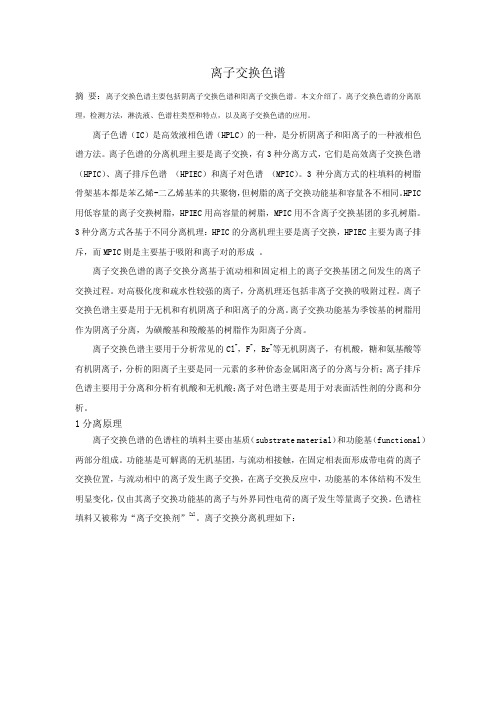
阴离子交换色谱中,淋洗液一般是 NaOH 或者 KOH,K2CO3/KHCO3 或者 Na2CO3/NaHCO3 混合 液。对于碱性 OH-淋洗液,非常容易吸收空气中的 CO2,溶入 CO2 的淋洗液的淋洗能力增强, 使得谱图基线不稳定,而且容易突然洗出难洗物造成鬼峰。本身配制 KOH 溶液时也存在认为 配制误差和固体试剂误差。“在线淋洗发生器”解决了这一难题。去离子水点解出 H+和 OH-, H+与 K+电解槽中的 K+进行阳离子交换,K+和 OH-则是所需的阴离子淋洗液。通过电流和流速 就可以控制 KOH 流量和浓度,这种方法使得梯度淋洗很容易实现。还可以用淋洗液生成器生 成阴离子交换色谱的 Ka2CO3/KHCO3 淋洗液以及阳离子的 MSA 淋洗液。对于分离单糖,多聚糖, 寡糖,常用 NaOH/NaAc 作梯度淋洗。
阳离子交换色谱中,使用抑制电导检测时,淋洗液可以使用 MSA 磺酸。对碱金属、胺和 小分子族胺的分离,常用的淋洗液是矿物酸,如 HCl 和 HNO3,常用浓度为 2-4 mmol/L。碱 土金属(二价阳离子)对阳离子交换树脂的吸附力太强,不能用矿物酸,一般用二价的淋洗 离子,如二胺基丙酸(DAP)、组胺酸、乙二酸、柠檬酸等。一种较好的选择是 2,3 二氨基丙 酸和 HCl 的混合液作为淋洗液。
色谱柱
阴离子 IonPac AS7 IonPac AS9-HC IonPac AS10 IonPac AS11 IonPac AS11-HC IonPac AS14A IonPac Pac PAX-100 IonPac AS15 IonPac AS16 IonPac AS17 IonPac AS18
图 1 离子交换分离机理 与离子交换色谱柱上的功能基交换的待测离子离子被淋洗液洗脱后,又与前面的功能将 进行离子交换,经过多次交换洗脱后才离开色谱柱。由于离子间交换的能力不同,而将各离 子分离开来,进入检测器进行检测。
色谱柱使用规程AS11
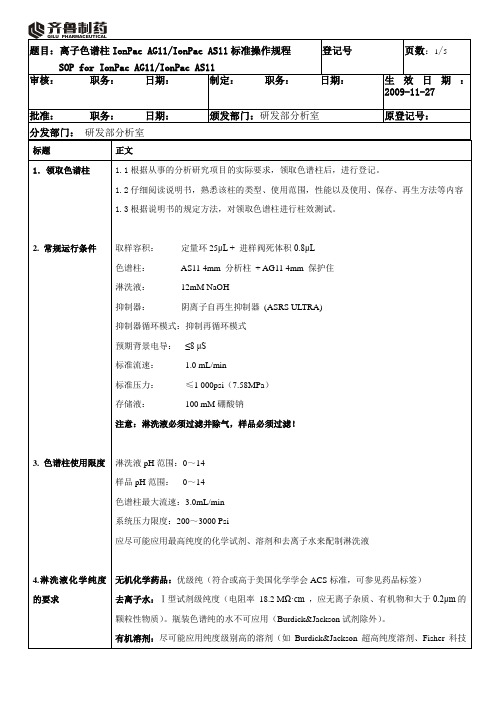
注意:
应用含有机溶剂的淋洗液时,抑制器要在自动抑制外部水模式下工作。
≤3000psi
色谱柱封存的淋洗液为色谱柱测试时使用的淋洗液。
将色谱柱安装到仪器色谱模块上,按照色谱测试指明的条件下配制淋洗液,并测试色谱柱的性能,连续进行被测标准品的测试,直到色谱保留时间能够重现。当色谱保留时间能够连续的重现时,说明色谱柱已经平衡好。
B.浓酸性溶液如1~3MHCl,可通过离子抑制原理去除高价态亲水性离子
并可以去除氯离子。可去除大多金属残留,如果处理后依然有金属残留,建议用多价酸,如0.2M草酸处理。
C.有机溶剂如果仅含有疏水性和非电离的污染物,可以单独使用有机溶剂进行清洗。有机溶剂极性的选择极性应随着杂质的疏水性增强而减小,并且是AS11允许使用的有机溶剂范围内(见表1)。
淋洗液中NaOH浓度(mM)
0.08(0.0525)
1
0.40(0.262)
5
0.96(0.63)
12
8.00(5.25)
100
16.00(10.5)
200
AS11可适用通常的色谱溶剂(浓度范围0~100%)
有机溶剂与水应提前混合
保证所有的无机化学药品在高浓度有机溶剂淋洗液中可溶
应用纯度级别尽可能高的溶剂
短期和长期储存都用100mM硼酸钠作储存液,用储存液冲洗柱子至少10分钟,用柱子自带的堵头封住两端。
分三种方案:除酸性可溶物、碱性可溶物和有机污染物,可合并为一个梯度方法,但应注意:
清洗过程中淋洗液的交替,要避免造成局部高压区,不可逆破坏色谱柱性能。
局部高压区可能由以下几种操作造成:
阴离子交换液相色谱柱
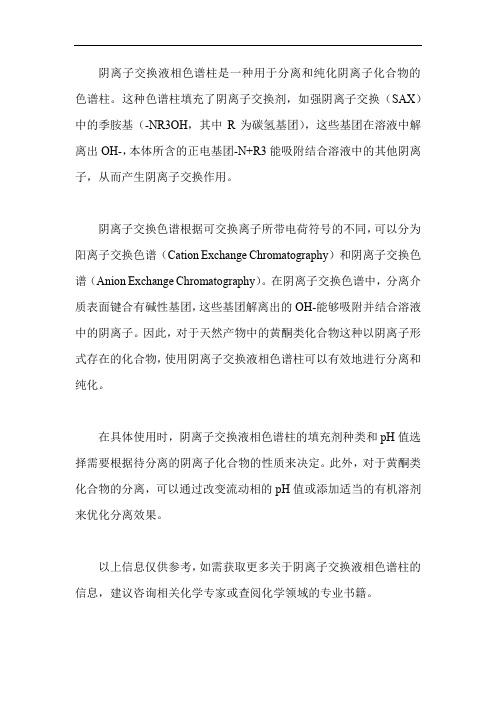
阴离子交换液相色谱柱是一种用于分离和纯化阴离子化合物的色谱柱。
这种色谱柱填充了阴离子交换剂,如强阴离子交换(SAX)中的季胺基(-NR3OH,其中R为碳氢基团),这些基团在溶液中解离出OH-,本体所含的正电基团-N+R3能吸附结合溶液中的其他阴离子,从而产生阴离子交换作用。
阴离子交换色谱根据可交换离子所带电荷符号的不同,可以分为阳离子交换色谱(Cation Exchange Chromatography)和阴离子交换色谱(Anion Exchange Chromatography)。
在阴离子交换色谱中,分离介质表面键合有碱性基团,这些基团解离出的OH-能够吸附并结合溶液中的阴离子。
因此,对于天然产物中的黄酮类化合物这种以阴离子形式存在的化合物,使用阴离子交换液相色谱柱可以有效地进行分离和纯化。
在具体使用时,阴离子交换液相色谱柱的填充剂种类和pH值选择需要根据待分离的阴离子化合物的性质来决定。
此外,对于黄酮类化合物的分离,可以通过改变流动相的pH值或添加适当的有机溶剂来优化分离效果。
以上信息仅供参考,如需获取更多关于阴离子交换液相色谱柱的信息,建议咨询相关化学专家或查阅化学领域的专业书籍。
阴离子交换柱原理

阴离子交换柱原理
阴离子交换柱是一种常用的色谱柱,其原理是利用柱内填充的阴离子交换树脂
与待分离物质之间的静电相互作用,实现对待分离物质的分离和纯化。
阴离子交换柱广泛应用于生物化学、药物分析、环境监测等领域,具有分离效果好、操作简便等优点。
阴离子交换柱的原理可以从以下几个方面来进行解析:
首先,阴离子交换柱内填充的阴离子交换树脂具有大量的阴离子基团,这些基
团能够与待分离物质中的阳离子部分发生静电相互作用,从而实现对待分离物质的捕获和分离。
其次,阴离子交换柱在分离过程中,待分离物质通过柱床时,会与阴离子交换
树脂上的阴离子基团发生竞争性吸附,根据待分离物质与阴离子交换树脂之间的亲和力大小,待分离物质会以不同的速率被阴离子交换树脂捕获和分离。
最后,通过适当的洗脱条件,可以改变待分离物质与阴离子交换树脂之间的相
互作用,实现对待分离物质的洗脱,从而达到分离和纯化的目的。
在实际应用中,阴离子交换柱的选择和操作条件对分离效果具有重要影响。
首先,根据待分离物质的性质和分离要求,选择合适的阴离子交换树脂和柱型规格;其次,优化样品的预处理和进样条件,保证待分离物质能够充分与阴离子交换树脂发生相互作用;最后,合理选择洗脱条件和流动相,实现对待分离物质的高效洗脱。
总之,阴离子交换柱原理是基于静电相互作用实现对待分离物质的分离和纯化,通过合理选择柱和操作条件,可以实现对不同待分离物质的高效分离,具有广泛的应用前景。
阴离子交换柱原理
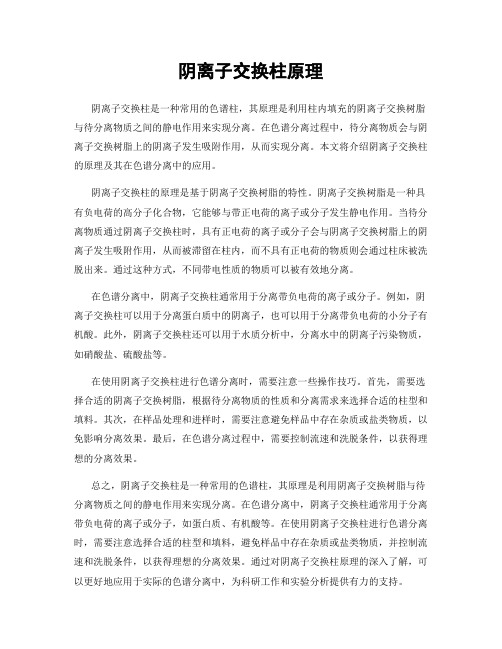
阴离子交换柱原理阴离子交换柱是一种常用的色谱柱,其原理是利用柱内填充的阴离子交换树脂与待分离物质之间的静电作用来实现分离。
在色谱分离过程中,待分离物质会与阴离子交换树脂上的阴离子发生吸附作用,从而实现分离。
本文将介绍阴离子交换柱的原理及其在色谱分离中的应用。
阴离子交换柱的原理是基于阴离子交换树脂的特性。
阴离子交换树脂是一种具有负电荷的高分子化合物,它能够与带正电荷的离子或分子发生静电作用。
当待分离物质通过阴离子交换柱时,具有正电荷的离子或分子会与阴离子交换树脂上的阴离子发生吸附作用,从而被滞留在柱内,而不具有正电荷的物质则会通过柱床被洗脱出来。
通过这种方式,不同带电性质的物质可以被有效地分离。
在色谱分离中,阴离子交换柱通常用于分离带负电荷的离子或分子。
例如,阴离子交换柱可以用于分离蛋白质中的阴离子,也可以用于分离带负电荷的小分子有机酸。
此外,阴离子交换柱还可以用于水质分析中,分离水中的阴离子污染物质,如硝酸盐、硫酸盐等。
在使用阴离子交换柱进行色谱分离时,需要注意一些操作技巧。
首先,需要选择合适的阴离子交换树脂,根据待分离物质的性质和分离需求来选择合适的柱型和填料。
其次,在样品处理和进样时,需要注意避免样品中存在杂质或盐类物质,以免影响分离效果。
最后,在色谱分离过程中,需要控制流速和洗脱条件,以获得理想的分离效果。
总之,阴离子交换柱是一种常用的色谱柱,其原理是利用阴离子交换树脂与待分离物质之间的静电作用来实现分离。
在色谱分离中,阴离子交换柱通常用于分离带负电荷的离子或分子,如蛋白质、有机酸等。
在使用阴离子交换柱进行色谱分离时,需要注意选择合适的柱型和填料,避免样品中存在杂质或盐类物质,并控制流速和洗脱条件,以获得理想的分离效果。
通过对阴离子交换柱原理的深入了解,可以更好地应用于实际的色谱分离中,为科研工作和实验分析提供有力的支持。
美国DIONEX(戴安)公司1996年新款离子色谱分离柱
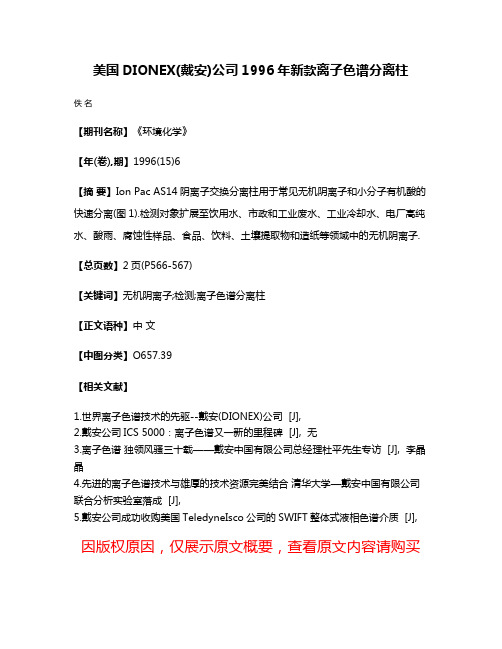
美国DIONEX(戴安)公司1996年新款离子色谱分离柱
佚名
【期刊名称】《环境化学》
【年(卷),期】1996(15)6
【摘要】Ion Pac AS14阴离子交换分离柱用于常见无机阴离子和小分子有机酸的快速分离(图1).检测对象扩展至饮用水、市政和工业废水、工业冷却水、电厂高纯水、酸雨、腐蚀性样品、食品、饮料、土壤提取物和造纸等领域中的无机阴离子.【总页数】2页(P566-567)
【关键词】无机阴离子;检测;离子色谱分离柱
【正文语种】中文
【中图分类】O657.39
【相关文献】
1.世界离子色谱技术的先驱--戴安(DIONEX)公司 [J],
2.戴安公司ICS 5000:离子色谱又一新的里程碑 [J], 无
3.离子色谱独领风骚三十载——戴安中国有限公司总经理杜平先生专访 [J], 李晶晶
4.先进的离子色谱技术与雄厚的技术资源完美结合清华大学—戴安中国有限公司联合分析实验室落成 [J],
5.戴安公司成功收购美国TeledyneIsco公司的SWIFT整体式液相色谱介质 [J],因版权原因,仅展示原文概要,查看原文内容请购买。
离子色谱测定啤酒中氟离子的情况说明
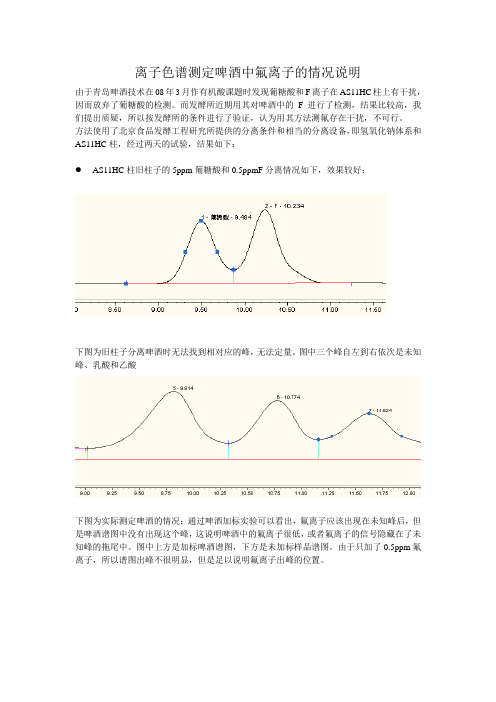
离子色谱测定啤酒中氟离子的情况说明由于青岛啤酒技术在08年3月作有机酸课题时发现葡糖酸和F离子在AS11HC柱上有干扰,因而放弃了葡糖酸的检测。
而发酵所近期用其对啤酒中的F进行了检测,结果比较高,我们提出质疑,所以按发酵所的条件进行了验证,认为用其方法测氟存在干扰,不可行。
方法使用了北京食品发酵工程研究所提供的分离条件和相当的分离设备,即氢氧化钠体系和AS11HC柱,经过两天的试验,结果如下:AS11HC柱旧柱子的5ppm葡糖酸和0.5ppmF分离情况如下,效果较好:下图为旧柱子分离啤酒时无法找到相对应的峰,无法定量。
图中三个峰自左到右依次是未知峰、乳酸和乙酸下图为实际测定啤酒的情况:通过啤酒加标实验可以看出,氟离子应该出现在未知峰后,但是啤酒谱图中没有出现这个峰,这说明啤酒中的氟离子很低,或者氟离子的信号隐藏在了未知峰的拖尾中。
图中上方是加标啤酒谱图,下方是未加标样品谱图。
由于只加了0.5ppm氟离子,所以谱图出峰不很明显,但是足以说明氟离子出峰的位置。
使用新购的AS11HC柱子的分离情况下图中,新柱子葡糖酸和氟离子保留时间极其接近。
图中上方是葡糖酸5ppm谱图,下方是氟离子0.5ppm谱图。
下图中,葡糖酸和氟离子混标只出现了一个峰,说明新柱子是无法将两种物质分开的。
下图为样品的实际测定图示,啤酒谱图中在未知峰后出现了一个峰,这个峰就是发酵所认为是氟离子的那个峰。
下图为啤酒加标试验:通过叠加啤酒谱图和未能分开的混标谱图可以看出,造成出现啤酒这个所谓氟离子峰的原因很可能是葡糖酸和氟离子共同作用的。
图中上方是啤酒谱图,下方是未能分开的混标。
●综合技术部的工作,结论如下:旧柱子虽然可以将混标分开,但是啤酒中无法分离出氟离子的峰,所以无法对啤酒进行检测,而新柱子根本就无法分离葡糖酸和氟离子这两种物质,也无法对啤酒中的氟离子进行检测。
发酵所的谱图中氟离子这个峰很可能是葡糖酸和氟离子的共流出信号,且这个峰与前面的未知峰分离度达不到1.5,使用峰面积积分定量是很不严谨和准确的。
离子色谱仪 交换柱

离子色谱仪是一种分离和分析离子化合物的仪器。
它使用离子交换柱作为分离介质,通过离子交换作用将待测样品中的离子与交换材料上的离子进行交换,从而实现离子的分离和分析。
交换柱是离子色谱仪中的重要部分,它通常由具有离子交换功能的材料制成。
这些材料可以是树脂或其他形式的固体颗粒。
交换柱内部充填着这些颗粒,待测样品通过柱体流过时,离子会与颗粒上的固定离子发生交换,从而实现分离。
交换柱的选择取决于待测样品中离子的性质和分析需求。
常见的交换柱类型包括阴离子交换柱和阳离子交换柱。
阴离子交换柱适用于分离分析阴离子,而阳离子交换柱适用于分离分析阳离子。
此外,还有一些特殊类型的交换柱,如离子排斥柱和离子亲和柱,用于特殊的离子分离和分析。
离子色谱仪中的交换柱通常具有一定的寿命,经过一定的使用次数后可能需要更换。
柱的选择、柱的操作条件以及样品的前处理等都会对柱的使用寿命产生影响。
因此,正确的使用和维护交换柱是保证离子色谱仪分析精度和稳定性的重要步骤之一。
戴安离子色谱技术参数-概述说明以及解释

戴安离子色谱技术参数-概述说明以及解释1.引言1.1 概述戴安离子色谱技术是一种广泛应用于分析领域的分离技术,它通过离子交换作用实现对溶液中不同离子的分离和定量测定。
该技术具有高灵敏度、高分辨率、宽线性范围以及对多种离子的同时分离能力等优点,被广泛应用于食品、环境、制药、农业等多个领域。
戴安离子色谱技术的原理是基于离子交换作用。
当样品通过戴安离子色谱柱时,溶液中的离子会与固定在色谱柱填料表面的离子交换树脂发生作用。
根据不同离子与交换树脂的亲和性和交换能力的差异,离子会以不同的速度通过色谱柱,从而实现对离子的分离。
通过检测溶液中各个离子的峰面积或峰高度,可以准确测定溶液中离子的浓度。
戴安离子色谱技术的参数主要包括离子交换树脂的种类和性能、溶液的流动速率和组成、色谱柱的尺寸和填料等。
离子交换树脂的选择应根据需要分离的离子种类和性质进行合理选择,以保证色谱柱对目标离子具有良好的选择性和灵敏度。
溶液的流动速率和组成对分离结果也有重要影响,过高或过低的流速都会影响分离效果。
此外,在进行戴安离子色谱分析时,选择合适的色谱柱尺寸和填料也是十分重要的,这将直接影响分离的效果和分析的灵敏度。
总之,戴安离子色谱技术是一种可靠、灵敏且广泛应用的分析技术,通过合理选择离子交换树脂、溶液流速和组成以及色谱柱尺寸和填料等参数,可以实现对溶液中离子的高效分离和定量测定。
在未来的研究中,可以进一步优化和改进这些参数,以满足对离子分离分析的更高要求。
1.2文章结构文章结构部分的内容可以包括以下内容:文章结构是指整篇文章的组织和安排方式,能够将各个章节和段落紧密地联系起来,使读者容易理解和把握文章的主题和内容。
正确的文章结构不仅可以提高文章的逻辑性和条理性,还可以增加读者的阅读舒适度和吸引力。
本文的结构主要分为引言、正文和结论三部分。
引言部分主要包括概述、文章结构和目的。
概述部分介绍了戴安离子色谱技术的基本概念和作用。
可以简要叙述离子色谱技术的发展历史、应用领域以及对于解决分析问题的重要性。
as11hc离子色谱柱说明书
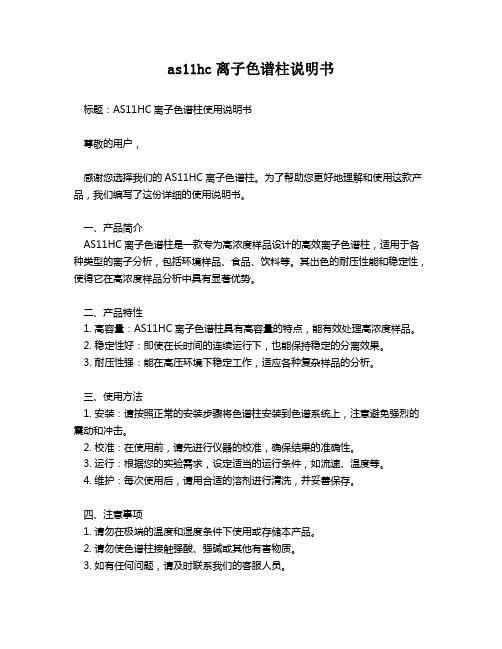
as11hc离子色谱柱说明书
标题:AS11HC离子色谱柱使用说明书
尊敬的用户,
感谢您选择我们的AS11HC离子色谱柱。
为了帮助您更好地理解和使用这款产品,我们编写了这份详细的使用说明书。
一、产品简介
AS11HC离子色谱柱是一款专为高浓度样品设计的高效离子色谱柱,适用于各种类型的离子分析,包括环境样品、食品、饮料等。
其出色的耐压性能和稳定性,使得它在高浓度样品分析中具有显著优势。
二、产品特性
1. 高容量:AS11HC离子色谱柱具有高容量的特点,能有效处理高浓度样品。
2. 稳定性好:即使在长时间的连续运行下,也能保持稳定的分离效果。
3. 耐压性强:能在高压环境下稳定工作,适应各种复杂样品的分析。
三、使用方法
1. 安装:请按照正常的安装步骤将色谱柱安装到色谱系统上,注意避免强烈的震动和冲击。
2. 校准:在使用前,请先进行仪器的校准,确保结果的准确性。
3. 运行:根据您的实验需求,设定适当的运行条件,如流速、温度等。
4. 维护:每次使用后,请用合适的溶剂进行清洗,并妥善保存。
四、注意事项
1. 请勿在极端的温度和湿度条件下使用或存储本产品。
2. 请勿使色谱柱接触强酸、强碱或其他有害物质。
3. 如有任何问题,请及时联系我们的客服人员。
五、售后服务
我们提供全面的售后服务和技术支持。
如果您在使用过程中遇到任何问题,或者对我们的产品有其他建议和意见,欢迎随时与我们联系。
再次感谢您选择我们的AS11HC离子色谱柱。
我们将一如既往地为您提供优质的产品和服务。
顺祝商祺,
[公司名称]。
氨基阴离子交换固相萃取柱
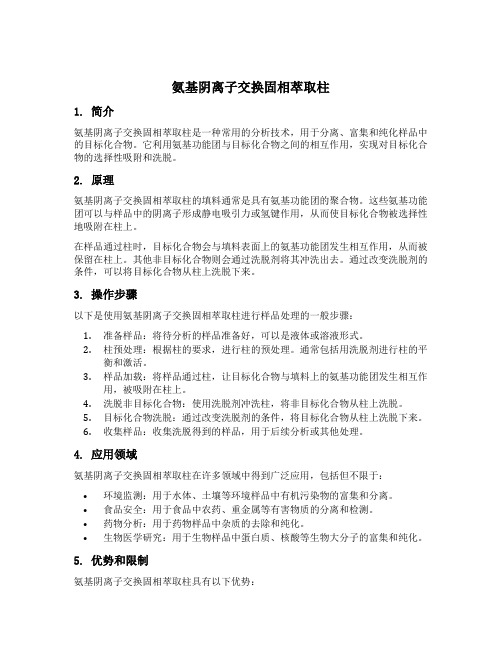
氨基阴离子交换固相萃取柱1. 简介氨基阴离子交换固相萃取柱是一种常用的分析技术,用于分离、富集和纯化样品中的目标化合物。
它利用氨基功能团与目标化合物之间的相互作用,实现对目标化合物的选择性吸附和洗脱。
2. 原理氨基阴离子交换固相萃取柱的填料通常是具有氨基功能团的聚合物。
这些氨基功能团可以与样品中的阴离子形成静电吸引力或氢键作用,从而使目标化合物被选择性地吸附在柱上。
在样品通过柱时,目标化合物会与填料表面上的氨基功能团发生相互作用,从而被保留在柱上。
其他非目标化合物则会通过洗脱剂将其冲洗出去。
通过改变洗脱剂的条件,可以将目标化合物从柱上洗脱下来。
3. 操作步骤以下是使用氨基阴离子交换固相萃取柱进行样品处理的一般步骤:1.准备样品:将待分析的样品准备好,可以是液体或溶液形式。
2.柱预处理:根据柱的要求,进行柱的预处理。
通常包括用洗脱剂进行柱的平衡和激活。
3.样品加载:将样品通过柱,让目标化合物与填料上的氨基功能团发生相互作用,被吸附在柱上。
4.洗脱非目标化合物:使用洗脱剂冲洗柱,将非目标化合物从柱上洗脱。
5.目标化合物洗脱:通过改变洗脱剂的条件,将目标化合物从柱上洗脱下来。
6.收集样品:收集洗脱得到的样品,用于后续分析或其他处理。
4. 应用领域氨基阴离子交换固相萃取柱在许多领域中得到广泛应用,包括但不限于:•环境监测:用于水体、土壤等环境样品中有机污染物的富集和分离。
•食品安全:用于食品中农药、重金属等有害物质的分离和检测。
•药物分析:用于药物样品中杂质的去除和纯化。
•生物医学研究:用于生物样品中蛋白质、核酸等生物大分子的富集和纯化。
5. 优势和限制氨基阴离子交换固相萃取柱具有以下优势:•选择性强:可以根据目标化合物的性质选择不同类型的氨基阴离子交换柱,实现对目标化合物的高效选择性吸附。
•富集能力强:可以将目标化合物从复杂的样品基质中富集到足够浓度,便于后续分析。
•操作简便:操作步骤相对简单,不需要复杂的仪器设备。
高分子聚合物基质阴离子交换柱
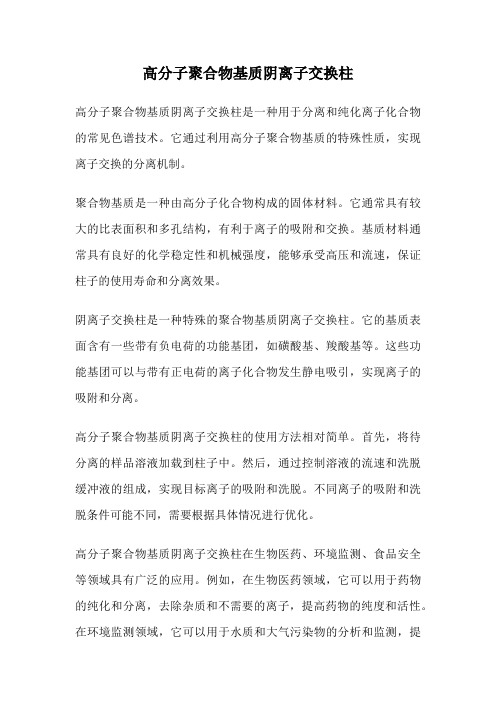
高分子聚合物基质阴离子交换柱高分子聚合物基质阴离子交换柱是一种用于分离和纯化离子化合物的常见色谱技术。
它通过利用高分子聚合物基质的特殊性质,实现离子交换的分离机制。
聚合物基质是一种由高分子化合物构成的固体材料。
它通常具有较大的比表面积和多孔结构,有利于离子的吸附和交换。
基质材料通常具有良好的化学稳定性和机械强度,能够承受高压和流速,保证柱子的使用寿命和分离效果。
阴离子交换柱是一种特殊的聚合物基质阴离子交换柱。
它的基质表面含有一些带有负电荷的功能基团,如磺酸基、羧酸基等。
这些功能基团可以与带有正电荷的离子化合物发生静电吸引,实现离子的吸附和分离。
高分子聚合物基质阴离子交换柱的使用方法相对简单。
首先,将待分离的样品溶液加载到柱子中。
然后,通过控制溶液的流速和洗脱缓冲液的组成,实现目标离子的吸附和洗脱。
不同离子的吸附和洗脱条件可能不同,需要根据具体情况进行优化。
高分子聚合物基质阴离子交换柱在生物医药、环境监测、食品安全等领域具有广泛的应用。
例如,在生物医药领域,它可以用于药物的纯化和分离,去除杂质和不需要的离子,提高药物的纯度和活性。
在环境监测领域,它可以用于水质和大气污染物的分析和监测,提供准确的数据支持。
在食品安全领域,它可以用于食品添加剂和农药残留物的分析和检测,保障食品的质量和安全。
高分子聚合物基质阴离子交换柱的选择和优化是关键。
不同的样品和离子化合物可能对柱子的选择和使用条件有不同的要求。
选择合适的柱子材料和尺寸,调整流速和缓冲液的组成,都会对分离效果和分离速度产生影响。
因此,在使用高分子聚合物基质阴离子交换柱时,需要根据实际需要进行实验和优化。
高分子聚合物基质阴离子交换柱是一种常用的色谱技术,用于离子化合物的分离和纯化。
它通过利用聚合物基质的特殊性质,实现离子交换的分离机制。
在不同的领域和应用中,它发挥着重要的作用,并为解决实际问题提供了有力的工具。
- 1、下载文档前请自行甄别文档内容的完整性,平台不提供额外的编辑、内容补充、找答案等附加服务。
- 2、"仅部分预览"的文档,不可在线预览部分如存在完整性等问题,可反馈申请退款(可完整预览的文档不适用该条件!)。
- 3、如文档侵犯您的权益,请联系客服反馈,我们会尽快为您处理(人工客服工作时间:9:00-18:30)。
戴安公司IonPac AS11和AS11-HC介绍
IonPac AS11/AS11-HC 阴离子交换分离柱用NaOH或KOH做淋洗液,用于无机阴离子和有机酸阴离子的快速分离,包括:无机阴离子;一价,二价,三价脂肪酸;Kreb’s循环酸;高电荷阴离子,如多聚磷酸盐,多聚硫酸盐,多聚碳酸盐;疏水性离子如I-,SCN-,S2O32-和ClO4-;核苷酸。
有机溶剂可匹配性方便阴离子交换选择性的控制,以及复杂基质分析后的清洗。
柱:IonPac AG11-HC,AS11-HC,4mm 检测器:抑制型电导,ASRS-ULTRA,
淋洗液A:KOH 自动抑制外加水模式
淋洗液B:NaOH 峰:1 奎尼酸55.0 mg/L 梯度: 1 mM from 0 to 8min 2 F- 0.8 to 30mM at 28min 3 乳酸根46.2
to 60mM at 38min 4 半乳糖醛酸根60.0
甲醇:10% from 0-38min 5 Cl- 1.0
流速: 1.5 mL/min 6 NO3-0.6
进样体积:10 uL 7 戊二酸根0.7
温度:30℃8 琥珀酸根 1.0
样品制备:1:10去离子水稀释9 苹果酸根116.0
图 2 KOH梯度淋洗,在AS11-HC柱上分析葡萄汁10 丙二酸根/酒石酸根190.0
11 马来酸根 2.0
12 SO42- 5.0
13 草酸根12.9
14 PO43-27.0
15 柠檬酸根80.0
16 异柠檬酸根 1.0
柱:IonPac AS11,AG11,4mm 流速:2.0 mL/min
淋洗液:KOH 进样体积:25uL
0.5 mM 等度2.5min 检测器:抑制型电导,ASRS,
to 5 mM at 6min, to 38 mM at 18min 自动抑制循环模式淋洗液发生器:EG40
峰:1 山梨酸根10.5 mg/L
样品制备:1:1000去离子水稀释
图 3 KOH梯度淋洗,在AS11柱上分析蛋糕霜糖中的山梨酸酯
柱:IonPac AG11,AS11 样品:60%过氧化氢(试剂级别,C1)淋洗液:1.5 mM NaOH 1:50稀释
3min 1.5-40 mM NaOH 峰:1 Chloride 0.42 mg/L
梯度,13min 2 Nitrate 22.0 流速:1 mL/min 3 Sulfate 0.74
进样体积:750 uL 4 Phosphate 170.0
检测器:抑制型电导,ASRS, 5 Pyrophosphate 33.0
自动抑制循环模式
图 4 用AS11柱测定60%稳定的过氧化氢溶液中的阴离子
柱:IonPac AS11,4mm 检测器:抑制型电导,ASRS , 淋洗液:45 mM NaOH ,在40%甲醇中 自动抑制外加水模式 流速: 1 mL/min 峰: 1 Fluoride 2 mg/L
进样体积:25 uL 2 Chloride 2
图 5 用AS11柱分离常见无机阴离子及I -,ClO 4-,SCN -和S 2O 32离子。
用含有有机溶剂的淋洗液缩短
强保留的疏水性离子I -,ClO 4-,SCN -和S 2O 32的保留时间,并改善其峰形。
柱:IonPac AS11,4mm 淋洗液:NaOH
20 mM to 80 mM in 10min
流速:2.0 mL/min
检测器:抑制型电导,ASRS ,
自动抑制循环模式
图 6 洗涤剂中聚磷酸盐的分离
3 Nitrate 5
4 Sulfate
5 5 Phosphate 10
6 Iodide 20
7 Thiocyanate 20
8 Thiosulfate 20
9 Perchlorate 20
峰:1 Chloride 3 mg/L 2 Carbonate _ 3 Sulfate 5 4 Phosphate 10 5 Pyrophosphate 10 6 Trimetaphosphate 10 7 Tripolyphosphate 10 8 Tetrapolyphosphate 10 9 Tetrametaphosphate 10 Unk=Unknown。
